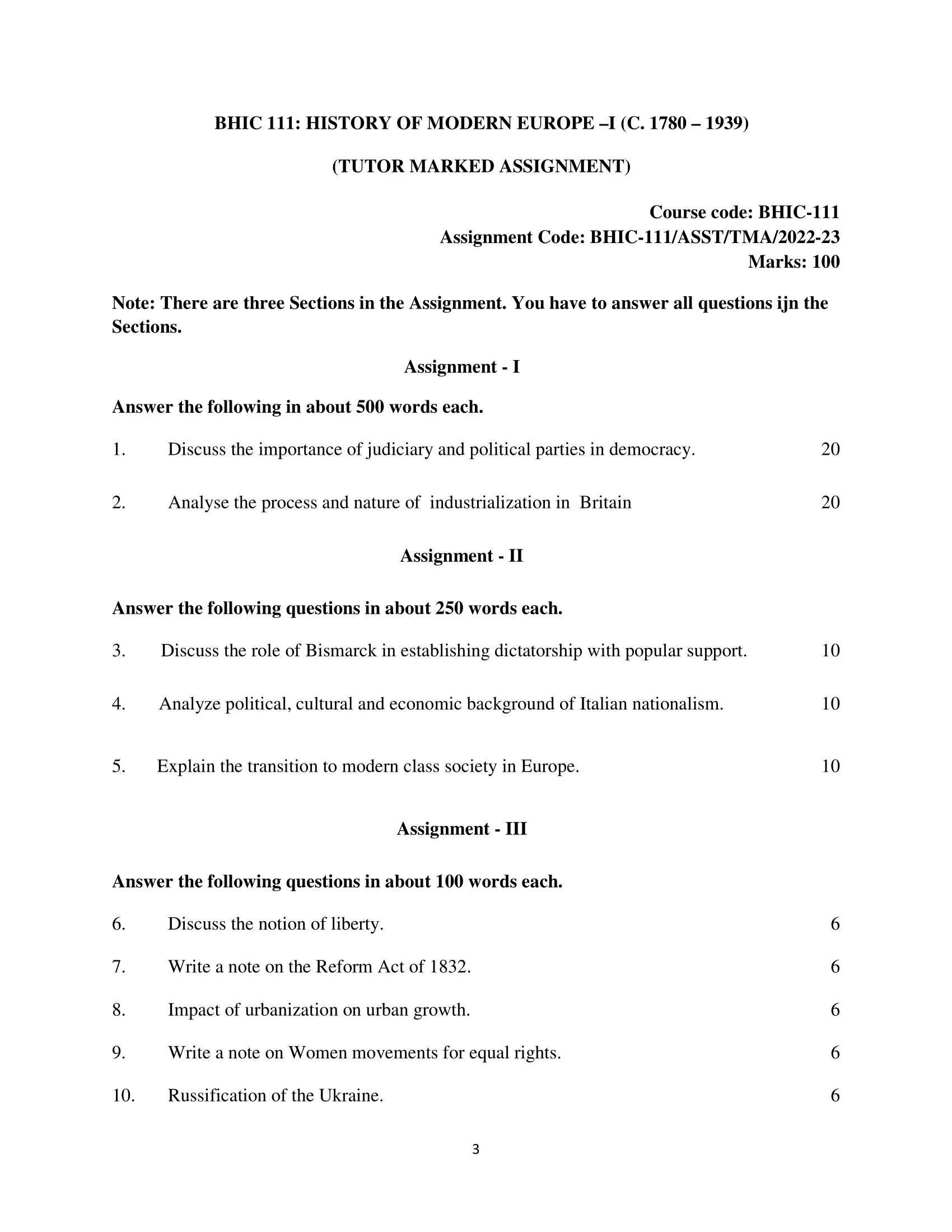Contents
- 1 Assignment – I
- 2 Answer the following in about 500 words each.
- 3 1. Discuss the importance of judiciary and political parties in democracy.
- 4 2. Analyse the process and nature of industrialization in Britain.
- 5 Assignment – II
- 6 Answer the following questions in about 250 words each.
- 7 3. Discuss the role of Bismarck in establishing dictatorship with popular support.
- 8 4. Analyze political, cultural and economic background of Italian nationalism.
- 9 5. Explain the transition to modern class society in Europe.
- 10 Assignment – III
- 11 Answer the following questions in about 100 words each.
- 12 6. Discuss the notion of liberty.
- 13 7. Write a note on the Reform Act of 1832.
- 14 8. Impact of urbanization on urban growth.
- 15 9. Write a note on Women movements for equal rights.
- 16 10. Russification of the Ukraine.

| Title | BHIC-111: IGNOU BAG Solved Assignment 2022-2023 |
| University | IGNOU |
| Degree | Bachelor Degree Programme |
| Course Code | BHIC-111 |
| Course Name | HISTORY OF MODERN EUROPE –I (C. 1780 – 1939) |
| Programme Name | Bachelor of Arts (General) |
| Programme Code | BAG |
| Total Marks | 100 |
| Year | 2022-2023 |
| Language | English |
| Assignment Code | BHIC-111/ASST/TMA/2022-23 |
| Last Date for Submission of Assignment: | For June Examination: 31st April For December Examination: 30th September |

Assignment – I
Answer the following in about 500 words each.
1. Discuss the importance of judiciary and political parties in democracy.
Ans: Judiciary and political parties are two important institutions in a democratic system. The judiciary is the branch of government that is responsible for interpreting the law and upholding the constitution, while political parties are organizations that represent different groups of citizens and compete for power through elections.
The importance of the judiciary in a democracy lies in its role as an independent and impartial body that is responsible for protecting the rights and freedoms of citizens. The judiciary is responsible for interpreting the law and resolving disputes, and it acts as a check on the power of the other branches of government. This helps to prevent abuses of power and ensure that the rule of law is maintained. In a democratic system, the judiciary serves as a safeguard against arbitrary actions by the government and provides a means for citizens to seek justice.
The judiciary is also responsible for interpreting the constitution and determining the constitutionality of laws and government actions. This is an important role, as it helps to ensure that the government operates within the boundaries established by the constitution and that the rights and freedoms of citizens are protected. In addition, the judiciary serves as a final court of appeal for citizens, providing a means for them to challenge government actions that they believe are unjust or unconstitutional.
Political parties play a crucial role in a democratic system by representing the interests and opinions of different groups of citizens. Political parties compete for power through elections, and the party that wins the election forms the government and has the responsibility of governing the country. Political parties provide citizens with a choice between different policies and ideologies, and they act as a link between the government and the people.
Political parties also help to ensure accountability in a democratic system. They provide opposition to the government, and they hold the government to account by scrutinizing its policies and actions. This helps to ensure that the government is responsive to the needs and concerns of citizens, and it helps to prevent abuses of power.
In addition, political parties help to ensure stability in a democratic system by providing a peaceful means for citizens to express their opinions and compete for power. Political parties provide a platform for citizens to engage in political discourse and to influence the government through elections. This helps to prevent unrest and conflict, and it allows citizens to express their opinions and have their voices heard in a peaceful and democratic manner.
2. Analyse the process and nature of industrialization in Britain.
Ans: The process of industrialization in Britain, also known as the First Industrial Revolution, took place between the late 18th and early 19th centuries and transformed Britain from an agrarian-based economy to an industrial one. This transformation had far-reaching impacts on the economy, society, and politics of Britain and set the stage for the spread of industrialization to other countries.
The primary factors driving the industrialization of Britain were the availability of natural resources, such as coal and iron, and the development of new technologies and transportation infrastructure. The steam engine, invented by James Watt in the late 18th century, revolutionized transportation and manufacturing, making it possible to power factories and transport goods over long distances. The development of canals and the expansion of the railway network also played an important role in the growth of industry.
The industrialization process in Britain was characterized by the growth of factories and the expansion of the textile industry. Textiles were the first industry to be transformed by the industrial revolution, and the growth of textile production helped to spur the development of other industries, such as iron and steel production. The growth of factories and the expansion of the textile industry created new job opportunities, attracting workers from rural areas to urban industrial centers.
The industrialization of Britain also had significant impacts on the economy and society. The growth of industry created new wealth, and Britain became one of the world’s leading economies. However, the growth of industry also led to significant social and economic inequality, as the wealth generated by industrialization was not distributed equally among the population. Working conditions in factories were often poor, and workers were subject to long hours and low wages.
Despite these challenges, the industrialization of Britain was a critical turning point in world history, and its impact was felt far beyond the country’s borders. The spread of industrialization to other countries led to the development of new technologies, increased economic growth, and a rise in living standards for many people. However, it also led to significant environmental degradation and contributed to the growth of social and economic inequality in many countries.
Assignment – II
Answer the following questions in about 250 words each.
3. Discuss the role of Bismarck in establishing dictatorship with popular support.
Ans: Otto von Bismarck played a crucial role in establishing dictatorship with popular support in Germany during the latter half of the 19th century. Bismarck was appointed as the Chancellor of Prussia in 1862 and quickly set about consolidating power in the hands of the central government. He did this by implementing various social and economic policies that appealed to the German people.
One of Bismarck’s most notable achievements was the introduction of the first national health insurance program in the world in 1883. This provided medical care and financial support to the working classes, who had previously been uninsured. Bismarck’s policies also included measures to regulate working hours, improve working conditions and protect the rights of workers. These policies earned him widespread popular support and helped to solidify his grip on power.
Bismarck was also instrumental in the creation of the German Empire in 1871, which brought together a number of smaller German states into a single, unified nation. This helped to increase the power and influence of the central government and further strengthen Bismarck’s dictatorship.
However, it is important to note that while Bismarck’s policies were popular, they were also authoritarian in nature. He was known for his uncompromising approach to politics and his willingness to use force to maintain order. Bismarck also imposed strict censorship laws and suppressed political opposition, effectively limiting freedom of speech and assembly.
Despite this, Bismarck’s dictatorship remained popular due to his successful management of the economy and his ability to maintain stability and security in Germany. He was seen as a strong leader who could be trusted to make the right decisions for the country. As a result, Bismarck was able to maintain his grip on power for over two decades and left a lasting legacy on German politics and society.
4. Analyze political, cultural and economic background of Italian nationalism.
Ans: Italian nationalism emerged in the 19th century as a response to the political, cultural and economic challenges facing Italy at the time. The country was divided into numerous small states, each with its own distinct culture, language and traditions. There was a growing sense of frustration among the Italian people at their lack of political power and the cultural and economic disparities between the north and south of the country.
Politically, the Italian Risorgimento movement, led by figures such as Giuseppe Garibaldi and Camillo di Cavour, aimed to unify Italy into a single, independent nation. This was in response to the domination of the Italian peninsula by foreign powers such as Austria and France. The Risorgimento leaders saw the creation of a unified Italy as a way to assert their independence and strengthen their bargaining position on the international stage.
Culturally, Italian nationalism was driven by the idea of a common national identity based on shared cultural values and traditions. This was reflected in the promotion of the Italian language as a unifying force, as well as the rediscovery of the country’s classical heritage. This cultural nationalism was also expressed through the creation of a national flag, the celebration of national holidays and the promotion of national symbols such as the Italian wolf.
Economically, Italian nationalism was fueled by the need to modernize the country and create a more equitable distribution of wealth. The unification of Italy brought with it the development of a national market and increased economic integration. This led to the growth of the Italian economy and the creation of new industries and jobs. However, the economic benefits of unification were not evenly distributed, with the north of the country experiencing faster growth than the south.
5. Explain the transition to modern class society in Europe.
Ans: The transition to modern class society in Europe was a complex and gradual process that took place over several centuries, from the medieval period to the Industrial Revolution. It was characterized by significant changes in the structure of society, the relationships between social groups and the distribution of wealth and power.
One of the key factors in the transition to modern class society was the growth of commerce and trade. As the economy of Europe expanded, the merchant class grew in wealth and influence, challenging the traditional feudal order. This was particularly evident in the cities, where a new urban middle class emerged, composed of merchants, artisans and other skilled workers.
Another important factor was the development of the capitalist mode of production, which involved the transformation of land and labor into commodities that could be bought and sold for profit. This change had a profound impact on the structure of society, as the traditional feudal relationships between lords and serfs were replaced by wage-based relationships between capitalists and workers.
The Industrial Revolution of the late 18th and early 19th centuries further accelerated the transition to modern class society. The mass production of goods and the growth of factories created new forms of work and new classes of workers, including the working class and the proletariat. The concentration of wealth and power in the hands of a small group of industrial capitalists marked the beginning of the modern era of class society.
The transition to modern class society was not uniform across Europe, and there were significant differences between countries and regions. In some areas, the transition was characterized by political revolution, while in others it was more gradual and incremental. Nevertheless, the end result was the emergence of a new social order based on the exploitation of wage labor and the concentration of wealth and power in the hands of a small ruling class.
Assignment – III
Answer the following questions in about 100 words each.
6. Discuss the notion of liberty.
Ans: Liberty is a political and philosophical concept that refers to the state of being free from external constraints, either by governments, institutions, or social norms. It is closely related to the idea of individual autonomy and the protection of individual rights. There are different interpretations of what liberty means, but one common understanding is that it encompasses the right to think, act, and express oneself freely, without fear of repression or discrimination.
Liberty is often seen as a cornerstone of democratic societies, where it is enshrined in constitutional protections and upheld by a robust system of checks and balances. However, it is also a contested idea, with debates over how to balance individual liberty with the needs of the wider community. Some argue that absolute liberty is not possible in practice, and that it must be limited in order to protect other values, such as security, equality, and public order.
7. Write a note on the Reform Act of 1832.
Ans: The Reform Act of 1832, also known as the Great Reform Act, was a landmark piece of legislation in 19th century Britain that aimed to address the growing demand for political reform. The act was passed in response to growing public discontent over the unequal distribution of political power, with a significant portion of the population excluded from the electoral system.
The Reform Act of 1832 extended the franchise to include more of the middle class, and removed some of the worst abuses of the electoral system, such as “rotten boroughs” (constituencies with very few electors that were under the control of a single person). The act also redefined the boundaries of parliamentary constituencies, giving urban areas greater representation in parliament.
The Reform Act of 1832 was seen as a major step forward in the development of the British democratic system, and paved the way for further reforms in the decades that followed. It was also seen as a triumph of the “Whig” (or liberal) tradition in British politics, and helped to establish the dominance of the middle class in the political system.
8. Impact of urbanization on urban growth.
Ans: Urbanization, or the growth of cities and the movement of people from rural areas to urban areas, has had a profound impact on urban growth and development. Urbanization has been driven by a variety of factors, including economic development, population growth, and technological advances.
One of the primary impacts of urbanization on urban growth has been the rapid expansion of cities. Urbanization has led to the creation of sprawling metropolises that have consumed vast amounts of land and transformed the landscape. This has created new opportunities for economic development and job creation, but it has also placed significant strain on the environment, including air and water pollution, traffic congestion, and the loss of green space.
Urbanization has also had a profound impact on the social and cultural fabric of cities. The growth of cities has created new social and cultural communities, but it has also led to the displacement of many communities, particularly low-income and marginalized groups. The concentration of people in cities has also created new social and economic challenges, including poverty, inequality, and crime.
Urbanization has also had a significant impact on the economy. Cities are centers of economic activity, and the growth of cities has led to the creation of new businesses, industries, and jobs. Urbanization has also led to the growth of the service sector, including finance, tourism, and technology, and has made cities key drivers of economic growth and development.
9. Write a note on Women movements for equal rights.
Ans: Women’s movements for equal rights refer to the various social, political, and cultural movements that have sought to challenge and overcome gender inequality and discrimination against women. These movements have been active throughout history, with the earliest recorded women’s rights movement taking place in the 19th century.
Women’s movements have been motivated by a variety of issues, including the right to vote, equal pay for equal work, reproductive rights, and an end to violence against women. These movements have used a variety of tactics, including protests, demonstrations, lobbying, and legal action, to advance their causes and to challenge laws, policies, and cultural attitudes that discriminate against women.
Women’s movements have achieved many significant victories, including the passage of laws and policies that provide women with equal rights and protections under the law. However, despite these gains, gender inequality and discrimination against women continue to be persistent problems in many societies around the world.
10. Russification of the Ukraine.
Ans: The Russification of Ukraine refers to the process of imposing Russian cultural, political, and linguistic dominance over Ukraine, which was part of the Russian Empire from the late 18th century until the early 20th century. This process involved the promotion of Russian language, culture, and identity at the expense of Ukrainian language, culture, and identity. The Russification of Ukraine was a result of the imperial policies of the Russian government and was intended to strengthen Russian control over Ukraine and to integrate Ukraine into the Russian Empire.
The Russification of Ukraine was implemented through a variety of means, including the promotion of the Russian language in schools and government institutions, the suppression of Ukrainian cultural and political organizations, and the forced relocation of Ukrainian peasants to other parts of the empire. The Russification of Ukraine was a source of conflict between Ukraine and Russia, and it contributed to the development of a Ukrainian national identity that was distinct from Russian identity. The process of Russification in Ukraine continues to be a sensitive issue in contemporary Ukraine and has had a lasting impact on Ukrainian culture and politics.
How to Download BHIC-111 Solved Assignment?
You can download it from the www.edukar.in, they have a big database for all the IGNOU solved assignments.
Is the BHIC-111 Solved Assignment Free?
Yes this is absolutely free to download the solved assignment from www.edukar.in
What is the last submission date for BHIC-111 Solved Assignment?
For June Examination: 31st April, For December Examination: 30th October
















